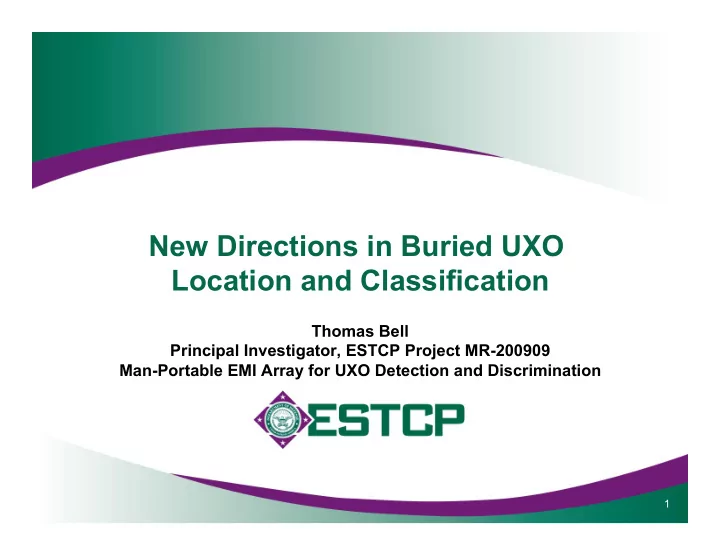

New Directions in Buried UXO Location and Classification Thomas Bell Principal Investigator, ESTCP Project MR-200909 Man-Portable EMI Array for UXO Detection and Discrimination 1
Introduction ● Why this talk, and why this talk right now? A. Because Andy was amazed at the performance recently demonstrated with advanced sensors doing both detection and classification at the ESTCP demonstration at the former Spencer Artillery Range, and B. He wants everyone to know that because of those successes he expects that the technology will start to be used sooner than later New Directions in Buried UXO Location and Identification 2
Outline ● Improving on current classification procedures EM61 survey followed by cued ID with advanced sensors Combined detection & classification with advanced sensors ● The 2x2 TEM advanced sensor array ● Expected detection performance relative to EM61 ● Former Spencer Range demonstration Detection performance Classification performance ● Summary ● Further development New Directions in Buried UXO Location and Identification 3
Typical ESTCP Classification Demonstration Workflow – Cued Identification 2. Map data, select 3. Collect data over flagged 1. EM61 survey anomalies, flag targets using advanced targets sensors, classify targets New Directions in Buried UXO Location and Identification 4
Typical ESTCP Classification Demonstration Workflow – Cued Identification Different 2. Map data, select 3. Collect data over flagged Sensors 1. EM61 survey anomalies, flag targets using advanced targets sensors, classify targets ~200/day New Directions in Buried UXO Location and Identification 5
Using Advanced Sensors for both Detection and Classification ● Potential benefits Reduced mobilization & equipment costs (one vs. two systems) Reduced flagging and/or cued ID (~200 anomalies per day) ● Performance Issues Detection performance relative to conventional EM61 Survey production rate relative to EM61 Classification performance with moving sensor Effects of terrain and vegetation New Directions in Buried UXO Location and Identification 6
2x2 TEMTADS ARRAY ● Cart-mounted EMI array Four transmitter loops Four 3-axis receivers GPS positioning ● Data acquisition modified for continuous survey operation Complete transmit cycle at 7.5 Hz Less averaging than static (cued ID) operation → some targets may still require cued data for classification New Directions in Buried UXO Location and Identification 7
Expected Detection Performance ● Standard response curves show minimum target signal vs. target depth ● Comparable 60mm detectability at 11x relative to noise levels from former Spencer Range surveys 2x2 average Z-axis transmit/receive, 1 s along track smoothing New Directions in Buried UXO Location and Identification 8
Spencer Range Demonstration ● ESTCP Classification Demonstration Program ● Former Spencer Artillery Range, Tennessee May 2012 37mm, 60mm, 75mm, 105mm & pipe seeds ● ½ ha dynamic area Open sky Easy terrain, vegetation New Directions in Buried UXO Location and Identification 9
EM61 and 2x2 Surveys ● EM61 0.5 m lane spacing Average speed 1.1 m/s ● 2x2 TEM array 0.4 m lane spacing Average speed 0.95 m/s Production rate ~80% of EM61 rate ● Basic 2x2 features same as EM61 EM61 2x2 Detail reflects higher resolution with 2x2 New Directions in Buried UXO Location and Identification 10
Survey Detail ● Basic 2x2 features same as EM61 ● Detail reflects higher resolution with 2x2 2x2 EM61 New Directions in Buried UXO Location and Identification 11
Detection Performance ● Thresholds set by minimum signal for 37mm at 34cm ● All TOI picked by 2x2 and E61 Ratio 2x2 signals to EM61signals for TOI as expected ● EM61-only and 2x2-only clutter picks generally near threshold level Some 2x2-only picks associated with unresolved EM61 anomalies 2x2 vs EM61 signal levels for Spencer Range anomalies New Directions in Buried UXO Location and Identification 12
Detection Performance ● Thresholds set by minimum signal for 37mm at 34cm ● All TOI picked by 2x2 and E61 Ratio 2x2 signals to EM61signals for TOI as expected ● EM61-only and 2x2-only clutter picks generally near threshold level Some 2x2-only picks associated with unresolved EM61 anomalies 2x2 vs EM61 signal levels for Spencer Range anomalies New Directions in Buried UXO Location and Identification 13
Detection Performance ● Thresholds set by minimum signal for 37mm at 34cm ● All TOI picked by 2x2 and E61 Ratio 2x2 signals to EM61signals for TOI as expected ● EM61-only and 2x2-only clutter picks generally near threshold level Some 2x2-only picks associated with unresolved EM61 anomalies 2x2 vs EM61 signal levels for Spencer Range anomalies New Directions in Buried UXO Location and Identification 14
Classification Performance ● 339 target anomalies 23 TOI (37mm, 60mm, 75mm, 105mm & pipe seeds) 316 clutter items ● 235 (69%) of anomalies classified using survey data only ● All TOI recovered with only18% of remaining clutter items excavated New Directions in Buried UXO Location and Identification 15
Summary ● Initial demonstration of combined detection and classification using advanced sensors at former Spencer Range went very well Detection performance comparable to EM61 Production rate ~80% of EM61 with 50cm lanes Eliminated ~70% of cued ID visits Classification eliminated ~80% of clutter digs ● Final development will be driven by 2013-14 ESTCP demonstrations and other field experience Probably production ready in late 2014 New Directions in Buried UXO Location and Identification 16
Further Developments ● Production rate improvements Wider lane spacing (requires better lane-to-lane registration) Alternative array configurations Vehicle-towed systems ● Cart/array design Decreased terrain/vegetation sensitivity ● Enhanced detection performance Smart anomaly selection that uses all available advanced sensor information New Directions in Buried UXO Location and Identification 17
Other Systems Capable of Combined Detection and Classification ● Various stages of development and testing OPTEMA MetalMapper MPV New Directions in Buried UXO Location and Identification 18
Recommend
More recommend